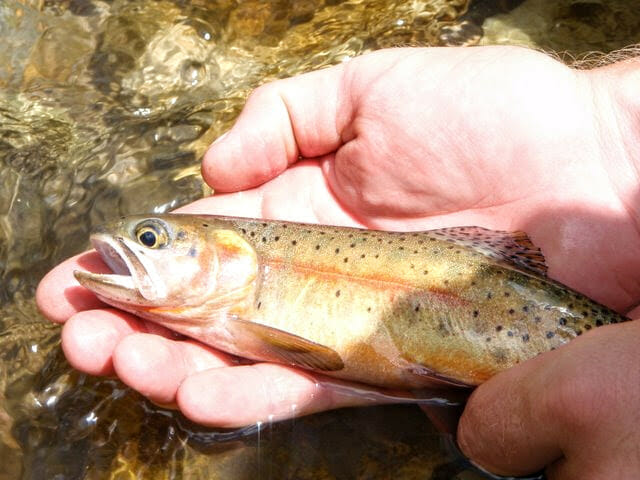Years and years ago, while attending college in western Colorado, I drove up the shoulders of the Sawatch Range between Salida and Gunnison as far as my old VW Beetle would make it on a road it had no business traversing. After reaching a stretch of two-track I could no longer navigate, I pulled the Bug off to the shoulder, grabbed my fly road and started walking.
I was following a tip from an old friend of mine in Gunnison who told me there was a high-mountain meadow stream at the end of the road, and in that stream were native cutthroat trout, a rarity, even 30 years ago. I wanted to see for myself.
About a mile up the road, I came across another vehicle—this one actually designed to handled the undercarriage-crushing rocks, the deep ruts and the general incline that’s common in the Colorado backcountry. An older gentlemen sat under the shade of his SUV’s hatchback. He was smoking a cigar and drinking a cold Coors. When he saw me round the bend, toting a fly rod and draped in a fishing vest, he nodded and waved hello.
I stopped at his rig, panting from the combination of thin air and the steep trudge. I nodded, too winded to really say much. I saw a stunning bamboo fly rod stretched from the back of vehicle to the front over the passenger seat. A pair of wet wading boots rested in the rocks at his bare, bone-white feet. A pair of soaked wool socks draped over the boots. His pants were wet to the knees.
After I caught my breath, I finally mustered the energy to ask, “How much farther to the creek?”
“Just another mile or so,” he said, grinning. Then he looked around at our stunning Rocky Mountain backdrop. Tall spruce trees lined the road. Massive, lichen-covered boulders—leftovers from ancient uplift and glacial retreat—pocked the landscape and a few scraggly aspens poked out of the the dark earth.
“Don’t see too many folks up here with a fly rod,” he said.
“First time here,” I said. “Heard there are cutties up here.”
I could tell he was a bit disappointed—someone had shared the secret, and here I was as a result.
“Well,” he said, “you’ve made it this far.”
Almost as if acquiescing to the inevitable—that, one solitary college kid was going to spread the news of native cutthroats like wildfire, and this special place was going to be overrun by anglers any minute now—the old man reached into his fishing creel and pulled out a fly box.
He opened the lid and, with time-worn fingers, lifted out two gorgeous mallard-wing flies, the likes of which I’d never seen before.
“Use these,” he said. “They’ll keep you entertained all day long.”
Then he explained that the Hare’s Ear wet flies were meant to be fished in the current and largely on the swing. I’d never fished wet flies before, so I was soaking in the education. But more than that, I was marveling at the sheer craftsmanship that went into each meticulously tied fly. The perfect proportions. The shine off the tinsel. The symmetrical mallard wings. Never could I hope to create such magic at the vise.
We chatted a bit more, and he gave a me a couple of beers to soak in the stream once I got there, and then he made to leave so he could make it home to Poncha Springs by dinnertime.
It was one of those perfect encounters. The only common thread the two of us had was the fish at the end of the road.
I continued my march up the mountain, and, sure enough, about mile farther, the road ended and, from off to the west, a beautiful mountain creek tumbled down from above timberline and opened into one of the most idyllic high-country meadows I’d ever laid eyes on.
I walked a bit farther to the creek, plopped the beers into the icy water atop some rocks, and tied on one of the old man’s Hare’s Ear wet flies.
He was right. Those stunning flies drew furious strikes from the fish that were as naive as the angler who cast to them. I spent an afternoon in small-stream heave catching 12-inch cutthroats, seemingly at will.
As the light faded, and the alpenglow started to shine atop the barren peaks above me, I retrieved the beers and downed them both on the hike back to the Bug.
I quickly stowed my gear and opened the driver’s side door, only to find another beer on the seat, resting atop a note.
“I have no idea how you got this far in this thing, but I hope fishing was worth it. One request. Let’s keep this place to ourselves,” the note, scrawled in pencil on a yellow piece of lined paper, read. “Glad to meet you today. Enjoy the beer.”
It was signed simply, “H.”
I never met the old man again, but I hung onto those flies for years, using them sparingly, always thinking I’d figure out how to tie them on my own. Eventually, even with infrequent use, they unraveled and fell victim to trout jaws, overhanging willows and the usual wear and tear that flies endure over the course of their oh-so-painfully short lives. Only now, decades later, have I been able to reasonably imitate the Hare’s Ear wet fly at the vise, but they don’t seem nearly as perfect as those gifted to me all those years ago.
I remember bouncing down the mountain that evening, traversing the rocky, nearly unnavigable road in the 1964 Beetle. I scraped the bottom more than once and striped the paint with spruce branches at least a dozen times.
But mostly I remember the reluctant generosity of an old man who didn’t have to share his flies … or his beer.
And I’ve kept our little secret.



